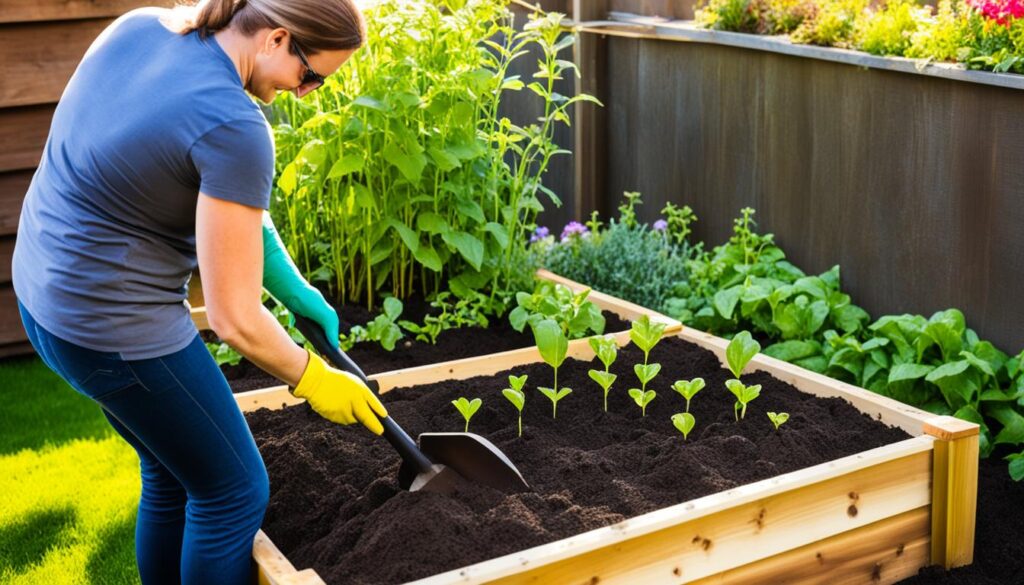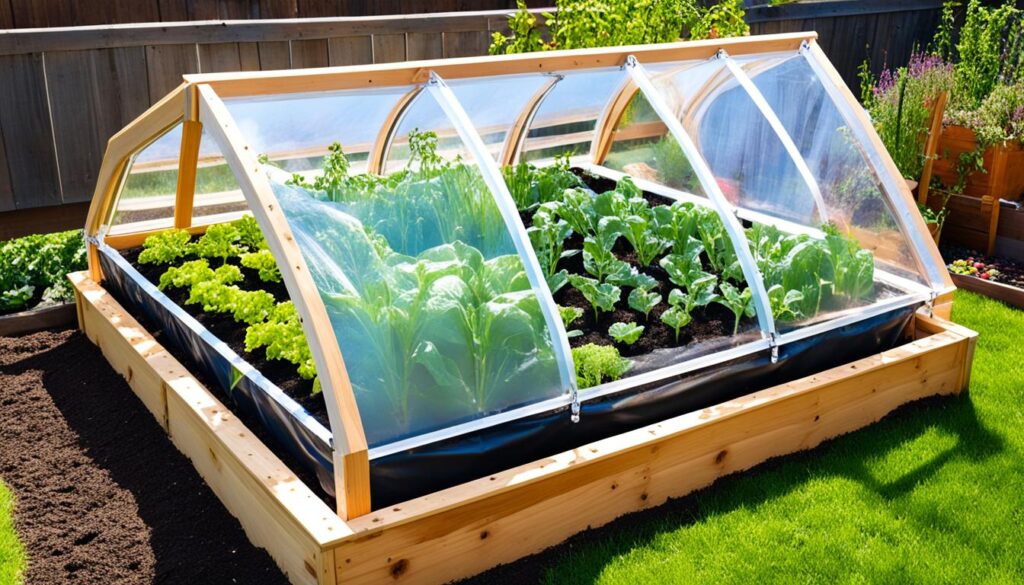As a gardener, I often encounter the frustration of seeing my daylilies’ leaves turn yellow during the summer months. This phenomenon can be perplexing and concerning, but it is essential to understand the various factors that contribute to this issue. By addressing the underlying causes and implementing proper care techniques, we can restore the beauty of our daylilies and ensure they thrive throughout the summer season.
Key Takeaways:
- Yellowing leaves in daylilies during summer can be a natural part of their growth cycle or a sign of underlying issues.
- Possible causes of yellowing leaves include insufficient watering, overwatering, disease, and pest infestation.
- To minimize yellowing leaves, remove infected leaves, water appropriately, address disease and pest problems, and consider disease-resistant cultivars.
- Proper fall care, such as cutting back plants and removing leaves, can help maintain daylily health.
- When considering chemical treatment, use caution and opt for environmentally friendly options.
The Natural Cycle of Daylilies in Summer
During the summer, daylilies undergo a natural growth cycle that is characterized by changes in their foliage. At the beginning of the season, daylilies produce lush green leaves, which serve as a backdrop to their beautiful and vibrant flowers. However, as the summer progresses, these leaves may start to turn yellow, a phenomenon known as daylilies leaf discoloration. This change in leaf color is a normal part of the daylilies’ annual cycle and should not cause concern.
As the days grow shorter and the temperature begins to cool, daylilies enter the end of their growing season. The yellowing of the leaves is an indication that the plant is preparing to go dormant for the upcoming winter. Eventually, these yellow leaves will wilt and collapse, marking the completion of the daylilies’ growth cycle for the year.
This natural yellowing of the leaves is influenced by the changing environmental conditions and is not necessarily a sign of poor daylilies summer care. It is simply a response to the seasonal changes that occur during the summer months.
It is important for gardeners to understand this natural cycle when caring for daylilies. While it can be disheartening to see the leaves change color, it is a normal part of the plant’s life cycle and does not necessarily indicate any underlying health issues.
Here is a visual representation of the natural cycle of daylilies in summer:
As seen in the image above, the daylily’s leaves begin to turn yellow as the summer progresses, eventually collapsing and marking the end of their annual cycle.
Insufficient Watering and Yellowing Leaves
When it comes to daylilies, one of the most common causes of yellowing leaves during the summer is insufficient watering. These beautiful plants require a significant amount of water, especially during their establishment phase. If they do not receive enough water, their leaves may start to turn yellow, indicating dehydration and stress.
To keep your daylilies looking their best, it is important to ensure that the soil remains consistently moist, but not waterlogged. This will provide them with an adequate water supply for their growth and development. On average, daylilies require about one inch of water per week, including rainfall, to thrive and prevent yellowing leaves due to lack of water.
Here are some tips for maintaining proper watering and preventing yellowing leaves in daylilies:
- Water consistently: Consistency is key when it comes to watering daylilies. Avoid allowing the soil to dry out completely between waterings, as this can lead to stress and yellowing leaves. Instead, aim to keep the soil moist by watering regularly.
- Monitor soil moisture: Check the moisture level of the soil regularly by inserting your finger into the ground. If the top inch of soil feels dry, it’s time to water your daylilies. However, be careful not to overwater them, as this can also result in yellowing leaves.
- Use a soaker hose or drip irrigation: Watering your daylilies directly at the soil level using a soaker hose or drip irrigation system can prevent wetting the leaves. This reduces the risk of fungal growth and minimizes the occurrence of yellowing leaves.
- Observe weather conditions: Be mindful of the weather conditions, especially during hot and dry periods. Daylilies may require more frequent watering during these times to compensate for the increased evaporation rate.
Proper watering is essential for daylilies’ summer maintenance and preventing leaf problems. By providing adequate water to your daylilies, you can help them stay healthy, vibrant, and free from the issue of yellowing leaves.
| Common Mistakes When Watering Daylilies | Correct Watering Practices |
|---|---|
| Watering sporadically | Watering consistently and regularly |
| Allowing the soil to dry out completely | Maintaining moist soil without overwatering |
| Watering from above, wetting the leaves | Watering at the soil level using a soaker hose or drip irrigation |
| Ignoring the weather conditions | Adjusting watering frequency based on weather conditions |
Remember, providing sufficient water is crucial for daylilies’ health and preventing yellowing leaves. By following proper watering practices, you can ensure that your daylilies thrive and showcase their beautiful foliage throughout the summer season.
Overwatering and Yellowing Leaves
Overwatering can have detrimental effects on the health of daylilies, leading to the yellowing of leaves. When daylilies are exposed to excessive moisture, the soil becomes overly saturated, causing the roots to suffer from root rot. This condition is characterized by slimy, mushy, and brown roots, which in turn result in the yellowing and wilting of leaves.
To prevent overwatering and maintain the plant’s health, it is important to water daylilies only when the top inch of the soil feels dry. This ensures that the plants receive adequate moisture without becoming waterlogged. Additionally, choosing a well-draining location for planting daylilies helps prevent water accumulation around the roots.
By maintaining proper watering practices, gardeners can ensure the optimal health of their daylilies, preventing yellowing leaves from occurring.
| Causes of Yellowing Leaves | Prevention |
|---|---|
| Overwatering | – Water daylilies when top inch of soil is dry – Choose well-draining location |
| Insufficient watering | – Ensure daylilies receive adequate water, especially in the establishment phase |
| Disease and pests | – Remove infected leaves – Address disease and pest problems promptly |
Disease and Yellowing Leaves
When it comes to daylilies, yellowing leaves can also be a sign of disease. One common disease that affects daylilies is daylily leaf streak, caused by the fungus Aureobasidium microstictum. This disease is characterized by the appearance of yellow or reddish streaks on the leaves, typically starting at the tips and spreading downwards. Eventually, the affected leaves wither and die completely.
Another disease to be aware of is daylily rust, which is characterized by the presence of orange spots on the leaves. These spots can spread and cause further damage to the foliage if left untreated.

To prevent disease in daylilies and minimize the occurrence of yellowing leaves, it is advisable to choose daylily cultivars that are resistant to fungal infections. By selecting disease-resistant varieties, you can help ensure the overall health and vitality of your daylilies.
Disease-Resistant Daylily Cultivars
| Daylily Cultivar | Disease Resistance |
|---|---|
| Betty Bennet | Resistant to daylily leaf streak |
| Edna Spalding | Resistant to daylily leaf streak |
| Ella Pettigrew | Resistant to daylily leaf streak |
By planting these disease-resistant cultivars, you can mitigate the risk of yellowing leaves and enjoy healthier, more vibrant daylilies in your garden.
Pest Infestation and Yellowing Leaves
When it comes to daylilies, pests can be a major cause of concern, leading to yellowing leaves and compromising the overall health of the plants. Aphids and mites are common pests that can infest daylilies and gradually cause the foliage to turn yellow. Identifying and addressing pest infestations promptly is crucial to maintain the plant’s health and vitality.
One effective method to protect daylilies from pests is by using insecticides or insecticidal soaps. These products can help control the pest population and prevent further damage to the leaves. Regular application of these measures is essential to ensure long-term pest control and minimize the risk of yellowing leaves.
It is important to remain vigilant and take action as soon as the signs of pest infestation are detected. Early intervention can significantly reduce the impact of pests on the daylilies’ foliage. Regular inspection of the plants, especially the undersides of leaves where pests tend to hide, will help catch infestations before they worsen.
“Pests can cause significant damage to daylilies if left unchecked. It’s essential to stay proactive and implement pest control measures to preserve the health of the plants and prevent yellowing leaves.”
By addressing pest infestation promptly and adopting effective pest control measures, daylilies can thrive and maintain their vibrant green foliage. Taking care of the plants’ health will not only enhance their visual appeal but also promote their overall well-being.
| Pest | Damage | Prevention and Control |
|---|---|---|
| Aphids | Feed on plant sap, causing leaf distortion and yellowing | – Rinse off aphids with a strong stream of water – Apply insecticidal soap – Introduce natural predators such as ladybugs or lacewings |
| Mites | Suck plant fluids from leaves, leading to discoloration and stippling | – Spray the leaves with water to increase humidity – Apply insecticidal soap specifically targeted at mites – Introduce predatory mites |
Preventing Pest Infestations in Daylilies
Prevention is key in maintaining daylilies’ health and preventing yellowing leaves caused by pest infestations. Here are some preventive measures you can take:
- Regularly inspect daylilies for early signs of pest activity
- Remove fallen leaves and debris that may serve as hiding spots for pests
- Mulch around the plants to discourage pests from reaching the leaves
- Encourage a diverse garden ecosystem with beneficial insects and birds that naturally control pest populations
By implementing preventive strategies and staying vigilant, you can ensure that daylilies stay healthy and free from the damaging effects of pests.
Minimizing Yellowing Leaves in Daylilies
To ensure the health and vibrancy of your daylilies, it is crucial to minimize the occurrence of yellowing leaves. By following proper care techniques, you can optimize their growth and prevent disease. Here are some essential tips:
- Remove infected leaves: One effective way to prevent the spread of disease is by promptly removing infected leaves. Gently pull or trim them off, taking care not to damage the healthy foliage. Remember to dispose of the infected leaves outside of the garden to avoid further contamination.
- Water at the soil level: To minimize the risk of fungal growth, it’s best to water your daylilies directly at the soil level. Consider using a soaker or drip system, which delivers water slowly and precisely to the roots. This method prevents wetting the leaves, reducing the likelihood of yellowing and disease.
- Avoid working with wet daylilies: Wet daylilies are more susceptible to disease. Avoid working with the plants when they are wet, as this can increase the risk of fungal infections. If it has recently rained or the foliage is wet, it’s best to wait until the plants have dried out before tending to them.
- Thin out plantings: Providing adequate air flow and sunlight penetration is essential for preventing disease and yellowing leaves. If your daylilies are densely planted, consider thinning them out. Creating space between the plants allows for better circulation and reduces the chances of fungal infections.
By implementing these care techniques, you can minimize yellowing and maintain healthy daylilies throughout the summer season.

Expert Tip:
“Regularly inspecting your daylilies for signs of disease and taking action promptly can make a significant difference in preventing yellowing leaves. Disease management is key to maintaining the health and beauty of your daylilies.” – Amy Thompson, Horticulturist
| Beneficial Techniques | Benefit |
|---|---|
| Removing infected leaves | Prevents the spread of disease |
| Watering at the soil level | Minimizes the risk of fungal growth |
| Avoiding working with wet daylilies | Reduces the chance of fungal infections |
| Thinning out plantings | Improves air flow and sunlight penetration |
Fall Care for Daylilies
Proper fall care is essential for maintaining the health of daylilies. As the summer comes to an end, it’s important to prepare your daylilies for the colder months ahead. By taking a few simple steps, you can promote the overall health of your daylilies and minimize the occurrence of yellowing leaves in the following year.
Cutting Back Daylilies
One key aspect of fall care for daylilies is cutting back the plants to the ground. This involves trimming off the foliage and removing any dead or dying leaves. By doing this, you eliminate potential sources of disease and pests that can manifest in decaying plant matter.
To cut back your daylilies, follow these steps:
- Using a sharp pair of garden shears, trim the daylilies down to the base of the plant.
- Remove any yellowing or damaged leaves.
- Dispose of the trimmed foliage away from your garden to prevent the spread of disease.
This practice not only helps prevent fungal diseases from overwintering but also encourages new growth in the following spring, leading to healthier daylilies overall.
Preventing Fungal Diseases
In addition to cutting back your daylilies, it’s crucial to remove fallen leaves from your garden. Leaves can harbor fungal spores, which can infect your daylilies during the winter months. By removing the leaves and disposing of them properly, you eliminate potential sources of infection and reduce the risk of yellowing leaves in the future.
Fall Care Checklist for Daylilies
| Task | Description |
|---|---|
| Cutting back daylilies | Trimming foliage to the ground to remove decaying leaves and promote new growth. |
| Removing fallen leaves | Clearing away fallen leaves to prevent the spread of fungal diseases. |
By following these fall care practices, you can contribute to the overall health of your daylilies and minimize the occurrence of yellowing leaves in the coming year. Taking the time to care for your daylilies in the fall sets the stage for vibrant and healthy foliage in the seasons to come.
Disease-Resistant Daylily Cultivars
If you find yourself dealing with persistent leaf streak or other diseases in your daylilies, don’t lose hope. There is a solution – disease-resistant cultivars. These special varieties of daylilies have shown impressive resistance to leaf streak and can help minimise disease-related issues, including yellowing leaves. By selecting disease-resistant cultivars like Betty Bennet, Edna Spalding, and Ella Pettigrew, you can significantly reduce the risk of diseases affecting your daylily plants, ensuring better plant health and leaf quality.

Selecting disease-resistant daylily cultivars plays a vital role in preventing yellowing leaves and promoting the overall well-being of your daylilies. These cultivars have been carefully bred and selected for their ability to resist certain diseases, providing you with peace of mind and healthier plants. By choosing disease-resistant cultivars, you can enjoy the beauty of vibrant daylilies with lush green foliage, ensuring a visual delight in your garden.
Considering Chemical Treatment
In severe cases of disease and yellowing leaves, I understand that as gardeners, you may consider applying a garden chemical to address the problem. However, it is crucial to exercise caution when using synthetic pesticides, herbicides, and disease controls. These chemicals can have negative effects on beneficial birds, insects, and the environment.
If you decide to opt for chemical treatment to restore daylilies’ plant health and combat leaf problems, I suggest selecting fungicides containing thiophanate-methyl or myclobutanil. These fungicides have proven effective in controlling diseases that contribute to yellowing leaves in daylilies. It’s imperative to follow the product instructions carefully to ensure safe and proper application.
Applying the fungicides in the early spring, when daylilies are emerging from dormancy, can help minimize environmental harm and effectively control the disease. Remember to always prioritize the well-being of your daylilies and the surrounding ecosystem when considering chemical treatments.
Chemical treatment should be approached as a last resort when other organic and preventive measures have been exhausted. Before resorting to synthetic chemicals, consider implementing cultural practices such as proper watering, removal of infected leaves, and choosing disease-resistant cultivars.
By adopting a holistic approach to daylilies’ plant health and addressing leaf problems, we can preserve the beauty and vitality of these stunning garden plants.
Successful Daylily Care and Healthy Foliage
With proper care and attention, daylilies can thrive and maintain healthy foliage. Adequate watering, avoiding overwatering or underwatering, and addressing disease and pest issues promptly are crucial for the overall health of the plants. By following recommended care techniques, gardeners can enjoy vibrant daylilies with lush green foliage throughout the summer and prevent the occurrence of yellowing leaves.
One of the key aspects of daylily care is ensuring they receive the right amount of water. Overwatering can lead to root rot and yellowing leaves, while underwatering can cause dehydration and leaf wilting. Finding the balance is essential. As a general guideline, daylilies require about an inch of water per week, including rainfall. Checking the moisture level of the soil regularly and adjusting watering accordingly can help maintain plant health.
Tip: Watering daylilies directly at the soil level using a soaker or drip system is recommended to prevent wetting the leaves, which can lead to fungal diseases.
Another important aspect of daylily care is addressing disease and pest issues promptly. Common diseases such as leaf streak and daylily rust can cause yellowing leaves and affect the overall health of the plants. Regularly inspecting the leaves for signs of disease and applying appropriate treatments, such as fungicides or disease-resistant cultivars, can help prevent the spread of infection.
Quote: “Preventing disease and promptly addressing any issues is essential for the long-term health and beauty of daylilies.” – Daylily enthusiast, Sarah Thompson
Pests can also pose a threat to daylily foliage. Aphids and mites are common pests that can infest the plants and cause leaf discoloration. Regularly monitoring and taking action at the first signs of pest infestation, using insecticides or insecticidal soap if necessary, can help protect the plants and maintain healthy foliage.
Tip: Thinning out daylily plantings can improve air circulation and sunlight penetration, reducing the risk of disease and promoting healthier foliage.
In conclusion, successful daylily care involves providing adequate watering, addressing disease and pest issues promptly, and ensuring proper airflow and sunlight for the plants. By following these care techniques, gardeners can enjoy the vibrant beauty of daylilies with healthy foliage throughout the summer months.
Restoring the Beauty of Daylilies
Dealing with yellowing leaves in daylilies can be frustrating, but with the right care, it is possible to restore their beauty. To begin, I recommend addressing the underlying causes of the yellowing. This may involve removing the yellowing leaves, which can be done by carefully trimming them off using sharp, clean pruning shears. By removing these leaves, we can prevent any potential spread of disease or pest infestations that may be causing the yellowing. Moreover, this will allow the plant to focus its energy on producing new, healthy foliage.
In addition to leaf removal, proper watering is crucial for the health of daylilies. For optimal care, it’s important to water the plants appropriately. One effective method is to water the daylilies directly at the soil level using a soaker or drip system. This helps prevent wetting the leaves, reducing the risk of fungal growth and yellowing. We should aim to keep the soil consistently moist, but not overly waterlogged, as this can lead to root rot and further yellowing of the foliage. Remember, daylilies require about one inch of water per week, including rainfall, to thrive during the summer season.
Preventing disease and pest infestations is another important aspect of daylily care. By maintaining a vigilant approach, we can catch and address any issues promptly. Regularly inspect the plants for signs of disease, such as leaf streak or daylily rust, and take appropriate measures to prevent their spread. Moreover, keeping an eye out for common pests like aphids and mites enables us to take timely action to control their population. Using an insecticide or insecticidal soap can be effective in managing these pests and minimizing damage to the leaves.
Lastly, consider planting disease-resistant cultivars to ensure the long-term health and beauty of your daylilies. Choosing varieties that are known for their resistance to common diseases, such as leaf streak, can significantly reduce the occurrence of yellowing leaves. Cultivars like Betty Bennet, Edna Spalding, and Ella Pettigrew have demonstrated resistance to leaf streak and are excellent options for gardeners looking to minimize disease-related issues. By implementing these care techniques and consistently monitoring the health of our daylilies, we can help them maintain vibrant and healthy foliage throughout the summer season.








